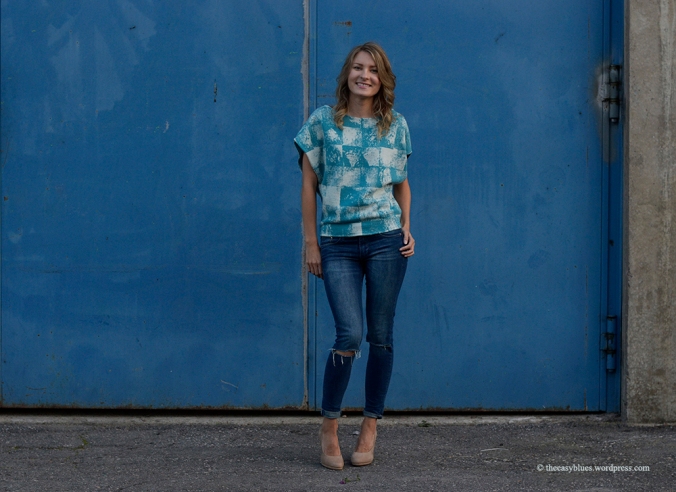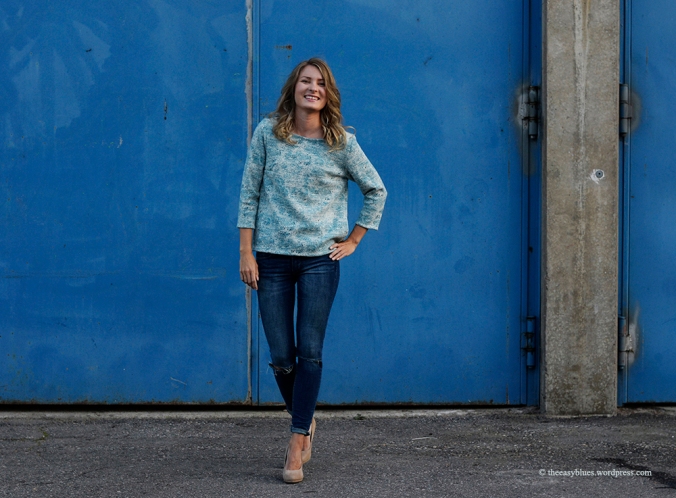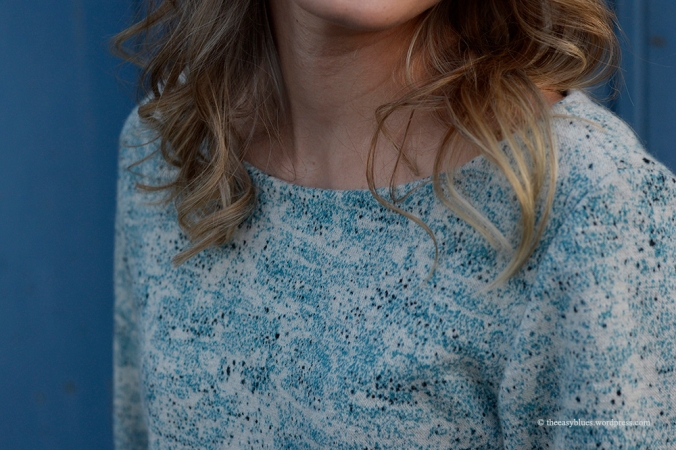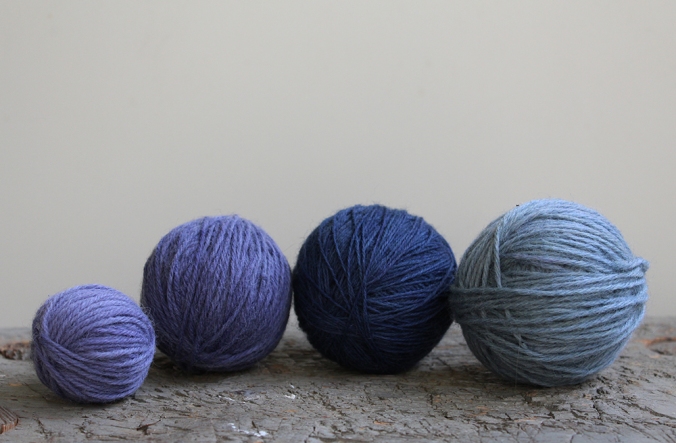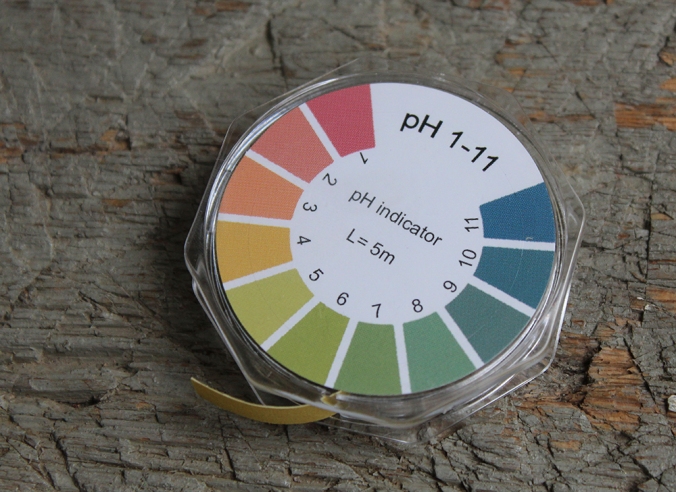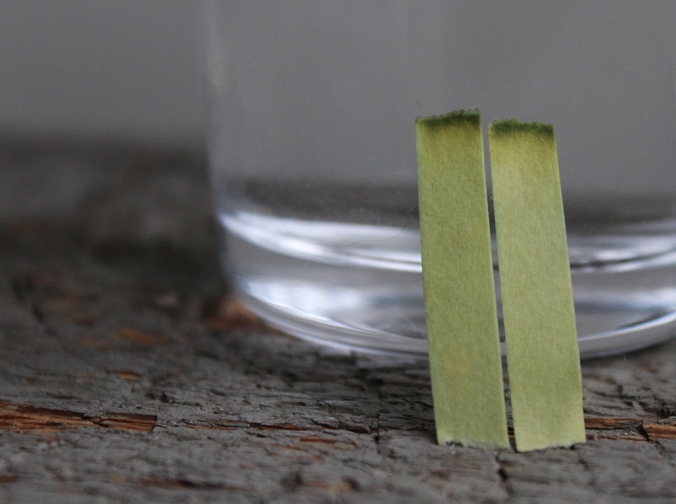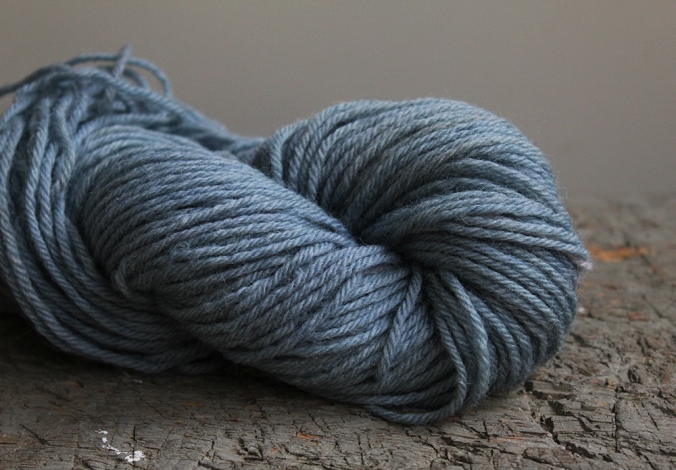I recently read a blog post by Mari at Gather and Grow, she had dyed with turmeric using solar dyeing and without any mordants. I had a look around in my spice rack and found a jar of turmeric powder that had expired four years ago. I decided to have a go with that. I used mordanted wool because that’s what I happened to have (alum and cream of tartar) and I also used heat. I heated the water and mixed the turmeric powder into it. When I added the wet yarn the dye immediately dyed the yarn and I only let the yarn be at the dye for 15 minutes. I used the the dye again and dyed another 100 g skein of wool and it came out exactly the same colour. Turmeric is strong stuff! I feel like a much less turmeric would have been enough and that I could still dye a lot of yarn with the dye. I have it saved it case I want more. The only downside is that the smell stays quite strong in the yarn, even though I rinsed it a lot.
Month: October 2014
Natural Dyeing: Mushrooms (Webcaps)
There is a one area of natural dyeing that I haven’t tried yet and that is mushroom dyeing. I have never liked eating mushrooms and so I have never been really interested in mushroom picking. Also that is why I’m pretty bad at naming different types of mushrooms. Chanterelle and fly amanita where the ones I knew for sure before my great mushroom adventure.
I have been reading a lot about mushroom dyeing lately and I have been especially interested in different cortinarius species (webcaps). These mushrooms are not edible, in fact most of them are poisonous and some are even lethal but for dyeing they are excellent. In the end of September I packed my bags and traveled to my parents place where there is a lot more forest and asked my dad to show me his best mushroom places. And this is what I found:
Cortinarius semisanguineus (In Finnish: verihelttaseitikki)
This is the bad boy that I most wanted to find. In Finnish its name means “the blood gill webcap” which pretty much sums its appearance up. Wikipedia says that in English it’s called either surprise webcap or red-gilled webcap.
At first it was very difficult to recognize it, but towards the end I got pretty good at spotting it. All webcaps have this little tip at their hat, many of them look similar from above, but when you turn them over you can check from the colour of the gills which one it is. In this case the gills are blood red although they turn more brow when older. The stem is firm and at the bottom it has a hint of red. This red-gilled webcap is an interesting dyeing mushroom because the hat contains red colour and the stem yellow. So you can have two colours from one mushroom or mix them up and make orange! In Finland these mushrooms grow in pine forests and I noticed that I could find more of them from dryer spots.
Cortinarius cinnamomeus (In Finnish. Kanelihelttaseitikki)
I’m pretty sure these mushrooms are cinnamon webcaps. They like to hang out at the same places as the red-gilled webcaps do. They also look very similar to them except for the cinnamon brown colour. They are more common that red-gilled webcaps so I found quite a lot of them. I heard that you are supposed to get brownish colour from them, but either my source is wrong or I didn’t pick the right mushrooms, because I don’t think I got any colour from these. Now I don’t even remember where I read about these.
Cortinarius sanguineus (In Finnish: veriseitikki)
I was so surprised to find these bloodred webcaps. They are named so because they are completely red, you can’t mistake them to anything else . I heard that this has not been a good year for them (too dry) and that they are more common in the more northern parts of Finland than here in the south. And that might be true as I only found seven of them. Mostly they were hiding under fir trees as they like to grow in old fir tree forests. This is amazing webcap, it gives out an amazingly strong colours. Apparently only 33 g of dried bloodred webcap will dye 100 g of yarn and even 5 g will get you a pink colour. Sadly I didn’t find enough of these to have a try.
Cortinarius croseus (In Finnish keltahelttaseitikki)
I also found a few saffron webcaps which have yellow gills. The mushroom is yellowish overall and surprise, surprise you can also get yellow colour from them. I only found a few of these.
I have understood that most of these species are European and some of them grown also in North-America. Correct me if I’m wrong. I mostly found cinnamon webcaps and red-gilled webcaps and I quickly realised, that you need quite a lot of mushrooms for dyeing, several kilograms. Because the mushrooms need to be dried before dyeing the weight decreases considerably. Unfortunately I wasn’t very lucky with the amount of mushrooms I found.
First I chopped the mushrooms into little pieces (the smaller the pieces the quicker they dry) and laid them on newspapers (some kind of airy net would have been better). You can use ovens or boiler rooms or even special vegetable dryers for dryeing but I used a sauna (being Finnish). Apparently you shouldn’t use too hot temperatures, I lifted the temperature to 40 °C and then let the sauna cool off. The mushrooms dried quite quickly over night. I must say though that the smell of the drying mushrooms is not the nicest. In the end I ended up with 26 g of dried red-gilled webcaps together with the few bloodred webcaps I found. I also got 44 g of what I though where cinnamon webcaps.
For dyeing I used a large 10 liter pot. I put the dried webcaps on the bottom and added little water (apparently the colour will dissolve better like this then with lot of water). I boiled the mushrooms for 30 minutes and after that I sifted the mushrooms away from the dye. I added water to the dye so that in the end I had 5 liter of dye. I had some lambswool yarn that I had mordanted with alum and cream of tartar beforehand. I wet that yarn and squished most of the water away and then added the yarn to the dye bath. I put the mushrooms inside old tights (pantyhose) and added them also to the dye. I used thighs so that the mushrooms would not be in direct contact with the yarn and make the colour uneven. I kept the temperature below 80 °C and kept moving the yarn every once in a while for one hour.
This is the colour that I got from the red-gilled webcaps, 26 g of them dyed 100 g of lambswool. I really really love this colour and I think its gorgeous. Very similar to the yarn I dyed with beetroot.
The cinnamon webcaps didn’t work so well. I did exactly the same thing with them, but I noticed that I wasn’t getting any colour out of them so I added to the dye the leftovers from the red-gilled webcap dye. I think that is where the most of the colour really came from.
Most of the information I found about mushroom dyeing I got from a Finnish mushroom dyeing book (Sienivärjäys) written by Anna-Karoliina Tetri. She has an online shop where she sells all kinds of things you need for natural dyeing and she has written several books on the subject (in Finnish). I met her briefly last spring before my natural dyeing adventures started and her shop is where I bought the alum and stuff to get started with all of this. Visit her web shop Tetri Design here.

I feel like I might need to point out one thing. I know that there are people from all around the world who read my blog and I have understood that in some countries it’s illegal to do mushroom picking or it’s regulated. However in Finland and other Scandinavian countries as well as Baltic countries we have a thing called “every man’s right” or “freedom to roam”.
In Finland this means that it is every man’s (or woman’s) right to walk, ski or camp in nature as long as you don’t disturb people or destroy nature. You are also allowed to pick berries and mushrooms as long as they are not protected species. I’m now talking about both public and privet forests and also National parks with the exception or protected lands. It’s prohibited to collect moss or lichen without permission from the owner though. I mention this because I wanted to make sure my mushroom picking is all right and actually very popular hobby in Finland. The best thing about mushroom dyeing was the part were I walked in the forest, enjoyed the nature and found places I otherwise would have never found.
Jacquard knits
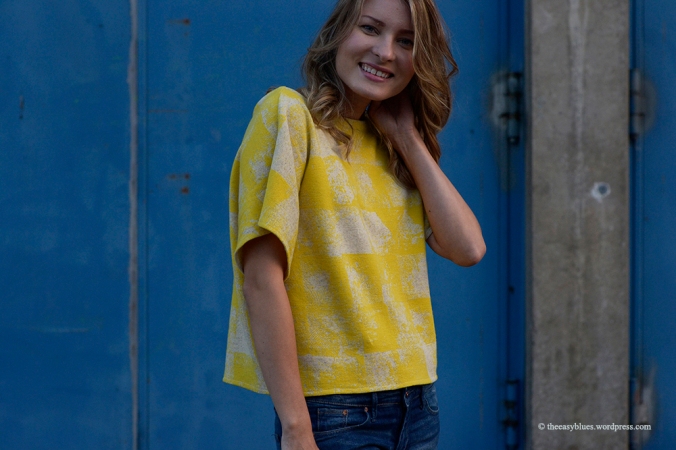
Two years ago I was as an exchange student at the Swedish School of Textiles in Borås, Sweden. It’s a wonderful school and I learned a lot about textiles and especially about knitted textiles. I was very lucky to be able to try out the industrial jacquard knitting machine they have there. I knitted a little collection of fabrics as part of a sustainable textiles course, using materials like wool, linen and tensel. I like the fact that from the distance these fabrics look like they are printed, until you go close and you see the texture and then the feel of the fabric is very different. I was very excited about the project and I had a vision of the kind of clothes I would like to sew from these fabrics.
Two very busy years went by and the fabrics were hidden away in my closet, until this summer I finally had time to tackle the project I had started. The clothes that I visualised in my head were very simple in style so that they would complement the patterns. Once I but my mind into it, the clothes came together quite quickly and couple of weeks ago we had really fun photo shoot. The photos were taken by my very talented friend Riikka and the lovely model Marianna did a wonderful job. Thank you girls! I’m really happy the way the photos turned out. It’s so great to see the vision I had two years ago come to life finally.
I should also mention that the beautiful wooden necklace featured in the photos is by a British jewellery designer Kristy Frasier. I bought this honeycomb necklace when I was in Edinburgh and it’s my absolute favourite neckless at the moment. Check her website here.
Natural Dyeing: Black Beans, Part 2
You might remember that not so long ago I experimented with dyeing with black beans. My white wool yarns became violet and the grey yarn navy blue (below from left to right). I was a bit puzzled at the time why my yarn didn’t become sky blue as I expect to happen. Well, as you can see on the right, I did it! I changed quite a lot of factors, so I can’t be sure what was it that made the difference in the end.
I bought some pH indicator paper to test our tap water’s pH-level and compere it to the bottled spring waters pH level. My idea was that our tap waters pH would be much lower and that would explain the violet colour. Well, it turned out that both water’s measured identical 6, so there goes my theory. To give some perspective number 7 is the neutral pH level, pH less than 7 are acidic and solutions with a pH greater than 7 are basic or alkaline. The last time I’ve had to think about things like this was at chemistry class in school.
I did test what would happen if I mix some vinegar to the water and that did drop the pH to 4. When I was using the black beans for the first time, I did put some vinegar to the last rinsing water so that might have something to do with the violet colour. Still I swear that the colour was already violet before that.
The other factors I changed were:
The beans. I changed the brand of black beans I used. Although they were both imported from China and the only difference was that the new ones were organic.
The yarn. Both yarns were 100% lambswool, only difference was that the first one was a Finnish yarn (and maybe a bit greasier) and the other yarn was from Peru.
Mordanting. The first time I used only alum as mordant, but the second time I used both alum and the cream of tartar. I got a comment to my post about red cabbage from VerenaErin and she said that alum itself is very acidic. I tested it by mixing some alum to tap water and the pH-level dropped to 4 and after I added some cream of tartar I got 3. But that is just confusing me even more.
The time. The first time around I let the yarn soak in the dye for 24 hours and the second time 48 hours, so twice as long.
No vinegar. First time I did this I noticed that the colour kept on getting off when I was doing the rinsing afterwards. I added a pit of vinegar to the rinsing water which I also think might have highlighted the violet colour.
The last time I also notice that the colour kept on getting off even after the yarn was dry. But this time it was much easier to rinse the yarn and the colour stayed. So which one of the factors listed above is responsible for this? I’m puzzled. But anyhow, I did manage to get the blue I wanted in the end! Even though I have no clue how.




















